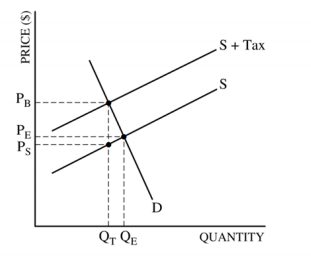
For simplicity, Figure 1 omits the shift in the supply curve. Since we can view a tax as raising the costs of production, this could also be represented by a leftward shift of the supply curve, where the new supply curve would intercept the demand at the new quantity Qt. The new market price is Pc, but sellers receive only Pp per unit sold, as they pay Pc-Pp to the government.
The imposition of a per unit tax on a product Pc#
The distance between Pc and Pp is the tax rate. In other words, of the total price paid by consumers, part is retained by the sellers and part is paid to the government in the form of a tax. By introducing a tax, the government essentially creates a wedge between the price paid by consumers Pc and the price received by producers Pp. While consumers may have other vacation choices, sellers can’t easily move their businesses. In Figure 1(a), the supply is inelastic and the demand is elastic, such as in the example of beachfront hotels. The more elastic the demand and supply curves, the lower the tax revenue.

(b) When the supply is more elastic than demand, the tax incidence on consumers Pc – Pe is larger than the tax incidence on producers Pe – Pp. (a) When the demand is more elastic than supply, the tax incidence on consumers Pc – Pe is lower than the tax incidence on producers Pe – Pp. Pe is the equilibrium price prior to introduction of the tax. The vertical distance between Pc and Pp is the amount of the tax per unit. Figure 1 illustrates this relationship between the tax incidence and elasticity of demand and supply.įigure 1. An excise tax introduces a wedge between the price paid by consumers (Pc) and the price received by producers (Pp). The tax would result in a much lower quantity sold instead of lower prices received. If the supply was elastic and sellers had the possibility of reorganizing their businesses to avoid supplying the taxed good, the tax burden on the sellers would be much smaller. The tax burden now passes on to the sellers. Similarly, when a government introduces a tax in a market with an inelastic supply, such as, for example, beachfront hotels, and sellers have no alternative than to accept lower prices for their business, taxes do not greatly affect the equilibrium quantity. The government can then pass the tax burden along to consumers in the form of higher prices, without much of a decline in the equilibrium quantity. In the case of smoking, the demand is inelastic because consumers are addicted to the product.

When the demand is inelastic, consumers are not very responsive to price changes, and the quantity demanded reduces only modestly when the tax is introduced. If the apple farmer can raise prices by an amount less than $1, then consumers and the farmer are sharing the tax burden. If demand is more inelastic than supply, consumers bear m ost of the tax burden, and if supply is more inelastic than demand, sellers bear most of the tax burden. On the other hand, if the apple farmer is unable to raise prices because the product is price elastic, the farmer has to bear the burden of the tax through decreased revenues, therefore the tax incidence falls on the farmer. In this situation, consumers bear the entire burden of the tax, or the tax incidence falls on consumers. If the product (apples) is price inelastic to the consumer then the farmer is able to pass the entire tax on to consumers of apples by raising the price by $1. Imagine a $1 tax on every barrel of apples that an apple farmer produces. The size of these changes depends on the price elasticities of demand and supply. You can see that as reductions in consumer surplus, reductions in producer surplus and deadweight loss. Note also, that when taxes on sales affect the equilibrium quantity, there are effects on economic welfare. In the tobacco example, the tax burden falls on the most inelastic side of the market. However, if one wants to predict which group will bear most of the burden, all one needs to do is examine the elasticity of demand and supply. Typically, the t ax incidence, or burden, falls both on the consumers and producers of the taxed good.

Look closely at the graphs towards the end of the video to graphically see how different elasticities cause the tax incidence to shift. When the demand is inelastic, consumers pay more of the tax, but when demand is elastic, the burden falls on the producers. This video introduces the idea of the tax burden and demonstrates how taxes impact both consumers and producers.


 0 kommentar(er)
0 kommentar(er)
